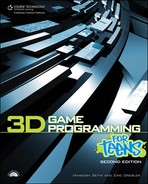Summary
Well, I hope you enjoyed this chapter. I tried to give the best explanation of style that I could, and hopefully I did a good job. I wrote this chapter because I believe style and clarity are important to every program and also because it is tough to find any style primers out there.
Once again, nothing in the chapter must be followed exactly. Style is an individual thing; what may appeal to one person may not appeal to the next. Try out all of the given styles and see which one fits you. The only thing I request of you is that you make your program simple and easy to understand. There is no need to use complex commands if you can get away with using a simpler block of code, even if it is a bit longer.
Try to get your programs to read like an essay—keep it organized and straightforward. Make sure you have your pre-program section listed, and try to comment any line of code that requires it. Make sure your style is consistent; if one function has an underscore between two words, make sure the next one does, too. Other than that, keep experimenting, and eventually you will develop your own style.
This chapter covered the following concepts:
Developing style
Comments
Function and variable names
Hey, we just finished Part I. Take a break if you feel like it, or jump straight into Part II. We are finally getting into graphics; I guarantee it’ll be more fun than you’ve ever had.
